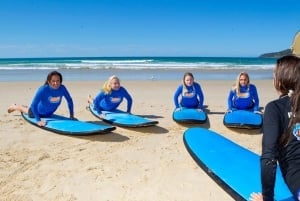Whale Watching
Gentle giants of the sea
Whales
From the end of May thru to November you can see these magnificent creatures as they migrate north from the chiily southern oceans of Antartica to the warmer waters of Northern Queensland. They make this trip so they can mate and calf before heading back to the deep south.
The Gold Coast is situated halfway on their epic journey. Their migration takes them along the northern NSW and Queensland coastlines.
Humpback whales are the most common to be seen. They average 10 meters but have been known to be 19 meters in size. They are the sixth largest mammal on the planet with only other whales being larger. They can be easily identified by their large pectoral fins which can be a third of their body length. The body is black with white patches on the underneath and fins.
They feed on krill, sardines, mackeral and other small fish with most of their feeding done in the Antartica waters.
The Southern Right whales can also sometimes be spotted in their migratory journey. They were called this because their high oil content and its fine silky baleen made it the right whale to hunt. The pregnant females would come close to the shores to give birth to protect the calves from sharks but unfortunately whalers have done more damage than the natural predators, killing calves and mothers. The right whale is also a slow swimmer making it an easier target for whalers. The whale is recognized by its distinct callosites (skin thickenings) around its jaws and eyes. It also has no dorsal fin like the humpback.
The Blue Whale is the largest of the whales and can grow up to 25 metres. Its heart is the size of a small car and its mouth can be 6 metres long. Calves are born after 11 months gestation and consume and estimated 380 litres of milk per day. Whaling has bought this species to the brink of extinction and they are now found in open oceans so sightings are extremely rare.
An estimated 2000 humpback whales make the journey each year. They spend their time building up fat reserves in the Antartica to complete their migratory journey. When winter arrives the whales set off for the warmer waters usually in May.
The warm waters of Northern Queensland provide a breeding ground for the whales. Mating occurs and calves are born the following year on their return. The pregnant whales are the first to leave the warmer waters so they can again feed on the krill located in the southern waters. The mothers with calves wait until last to let their calves built up as much body fat for the journey south.
As the whales migrate to the warmer weather you can often see them breaching. This is when they leap out of the water in which 40% of their body clears the water. Anything less is referred to as a lunge. Whales such as Sperm Whales perform a breach by swimming vertically upwards from depth and heading straight out of the water. The humpback whales swim close to the surface and then jerk themselves upwards at speed managing to get 90% of their body out of the water before it turns its body around to land on its back. And of course make the regulatory splash! The humpback, sperm whale and right whale are the most common whales to breach.
Spyhopping is when the whale rises and holds its position partially out of the water. The whale is able to maintain this position by positioning its pectoral fins use its natural buoyancy.
Lobtailing is when the whale lifts its fluke (tail) out of the water and splashes it back into the water. Like breaching it is more common among the humpbacks, sperm whales and right whales.
Logging is when the whale floats on the water with little movement with only the dorsal fin and back exposed. This is common with right whales.
A peduncle throw is when a humpback pivots with its pectoral as it pushes its head down and thrusts its fluke and rear part of the body (penduncle ) out of the water and then turns sideways and crashes back into the water with considerable force. This action is usually seen when one whale is trying to see off another in a competitive environment. This may sometimes been seen as a reaction to a boat.
Whale songs are sung by males and is usually by solitary whales to attract attention during mating.
A white humpback whale has been seen in recent years and this is the only recorded sighting of an albino whale. He is called Migaloo and migrates with other humpbacks. He was seen in 2009 and so everyone will be looking out for him again in 2010. Migaloo is aboriginal for "big white fella".
There are a number of whale watching tours to take you out to sea on the coast to "whale alley" where you can see these magnificent mammals. The crews are all very informative and usually will have spotted a whale before any visitors. There are also dolphins and birdlife to see as well. The vessels range in size from large catamarans to smaller boats.
So grab your coat and camera and have a whale of a time!











